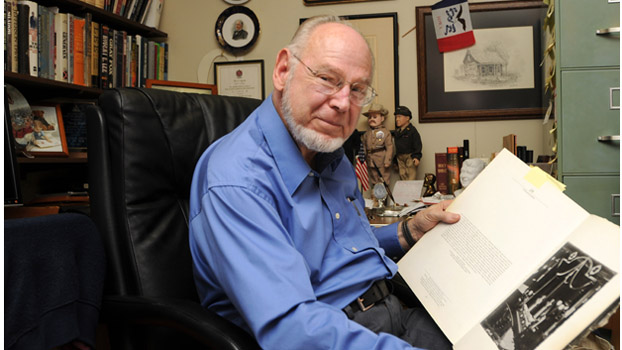 Caption: Ronald D. Rietveld in his campus office before he retired in 2009. He holds a book open to the photograph of Abraham Lincoln lying in state that he found as a teen. Photo by Kelly Lacefield Download image
Caption: Ronald D. Rietveld in his campus office before he retired in 2009. He holds a book open to the photograph of Abraham Lincoln lying in state that he found as a teen. Photo by Kelly Lacefield Download image
Lincoln and Secession
Historian Ronald Rietveld Delivers April 14 Talk on 16th President and the Civil War
Ronald D. Rietveld, who enjoyed fame at age 14 when he found a lost picture of Abraham Lincoln lying in his coffin, will deliver this year’s Rietveld Lecture Thursday, April 14.
The free, public lecture, “Lincoln and the Secession — Crisis and the Beginning of War,” is at 6 p.m. in Portola Pavilion of the Titan Student Union.
The lecture will focus on the secession crisis of 1860-61, as one Southern state after another declared its independence from the United States and formed the Confederate States of America.
“During those months of crisis, President-elect Lincoln overestimated the strength of Unionism in the seceded and non-seceded slave states and underestimated the willingness of the deep South to go to war,” said the emeritus professor of history.
“It was believed that the threats of secession were a ploy to intimidate the North into granting southern demands,” he added. “Lincoln called the crisis artificial, and, left alone, it would dissipate by itself. Convinced that secession was a rebellion of individuals, not states, he insisted that the Union remain intact, and the states retained all their constitutional rights.”
Lincoln’s inaugural address March 4, 1861, repudiated the right of secession, Rietveld said.
“It was illegal,” he said. “The increasing hostility on the part of the non-slave-holding states to the institution of slavery and the interference with returning fugitive slaves to bondage meant that slavery, not states’ rights, birthed the Civil War.”
With the federal garrison surrender at Fort Sumter April 14, 1861, the Civil War began — 150 years from the date of Rietveld’s upcoming lecture. April 14 also is the 146th anniversary of the day Lincoln was shot to death at Ford’s Theatre in Washington, D.C.
The Rietveld Lecture series was launched as a tribute to the Lincoln scholar in 2009, the year he retired from the university.
For more information, call 657-278-8475.
April 7, 2011
